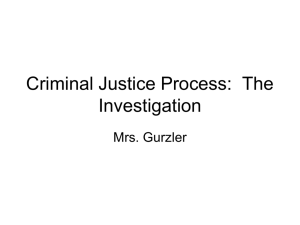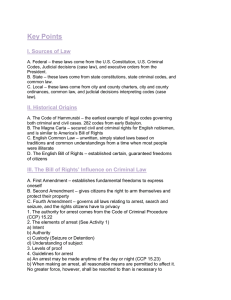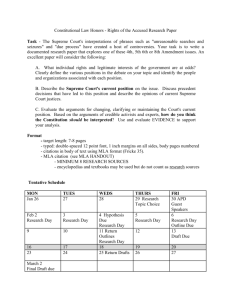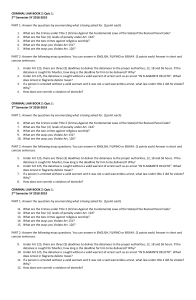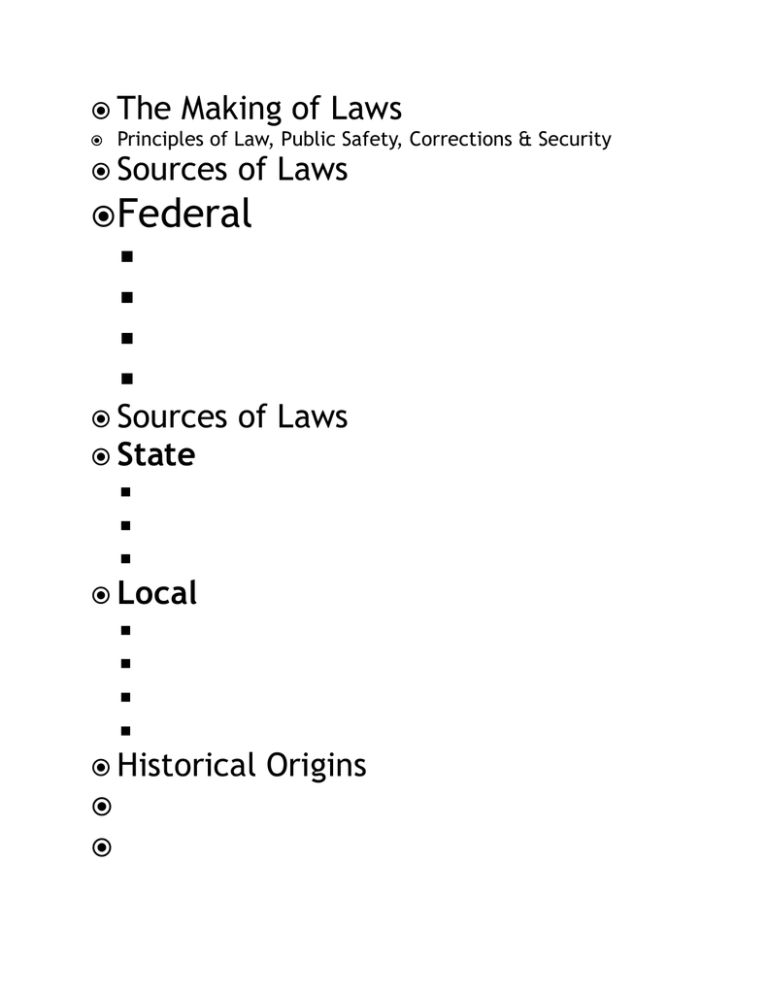
The
Making of Laws
Principles of Law, Public Safety, Corrections & Security
Sources
of Laws
Federal
Sources
of Laws
State
Local
Historical
Origins
Classifications
of Crimes
Class C Misdemeanor
Class
B Misdemeanor
Class
A Misdemeanor
Classifications
of Crimes
State Jail Felony (SJF):
3rd
Degree:
2nd
Degree:
1st
Degree:
Capital:
First
Amendment
Second
Amendment
Places
Weapons Prohibited
Penal Code 46.03, F3
A
person intentionally, knowing, or
recklessly possesses, or carries a
weapon onto the physical premises
of:
Unlawfully
Carrying a Weapon
Penal Code 46.02, class A
Fourth
Amendment
“The right of the people to be secure in
their persons, houses, papers, and
effects, against unreasonable searches
and seizures, shall not be violated, and
no Warrants shall issue, but upon
probable cause, supported by Oath or
affirmation, and particularly describing
the place to be searched, and the
persons or things to be seized.”
Arrest,
Search, and Seizure
CCP 15.22
A person is arrested when he has
been actually
placed___________________________
________________________________
______________ by an officer or
person executing a warrant of arrest,
or by a person who has the
authority to arrest
Elements of Arrest
Understanding of the subject
Guidelines
of Arrest
An arrest may be made ___________--________________________ (CCP
15.23).
When
making an arrest, all
reasonable means are permitted to
affect it. No greater
force,___________________________
________________________________
_______________________________
the arrest and detention of the
suspect (CCP 15.24)
Temporary Detention
Florida
v. Royer
Stops
Justified
if:
“Terry
Frisk”
Terry v. Ohio
Unusual Conduct
Careful pat of outer clothing
Search
Defined
Prying into hidden places for that
which is concealed; it is not a search
to observe that which is open to view
Search Warrant
Definition – CCP 18.01
N
P
Sworn affidavit
Must include:
Search
Beyond a Warrant
Hunt
for evidence or contraband
that, as a result of the initial search,
is believed to exist in another
location on the property
Exceptions to Search Warrant
Searches
Allowed at School
Vehicles
searches
The
use of metal detectors
Consent
to search
to Lawful Arrest
The arrest must be lawful
Contemporaneous
with arrest
Do
Plain-View
Doctrine
Coolidge v. New Hampshire
The initial intrusion must be lawful or
in proper position to view the
property.
The
It must be immediately apparent that
items are evidence of a crime,
contraband, or subject to seizure
Exclusionary
CCP
38.23
Rule
No
evidence shall be admitted into a
criminal trial that was obtained in
violation of constitutional rights
Mapp v. Ohio
Fifth
Amendment
Grand jury
Just
compensation for government
takings
Exceptions to Double Jeopardy
Convicted and asks for a new trial
Sixth
Amendment
Informed
of the nature and cause of
the accusation
Compulsory
process of witnesses
Eighth
Amendment
No
cruel and unusual punishment
Elements
of a Crime Definitions
Actus Reus
The
actions of the person
committing the crime as defined
by law
Mens
The
Rea
state of mind and intent of
the person committing the actus
reus
Actus
Reus
Physical or verbal acts that are voluntary
Possession of an illegal or prohibited
item
Constructive possession – does not have
physical or actual possession of an illegal
item but exercised care, custody, or
control over the contraband, knowing it
was illegal
Knowing possession – a person has actual
possession and knows that the item is
illegal
Mere possession – a person has actual
possession of an illegal item, but does
not know it is illegal
Mens
Rea
General intent – the logical outcomes
associated with a criminal act
Transferred intent – a person injures
another but did not intend to harm the
party
Constructive intent – the actor did not
intend to harm anyone but should have
known that his or her behavior created a
high risk of injury
Inchoate
Offenses
Solicitation
The incomplete crime of urging,
requesting, or commanding another
person to commit a crime
Conspiracy
A criminal act
requiring no action other
than communication
Attempt
A criminal
act amounting to more than
mere preparation
Classification
Crimes
T
of Crimes
against
P
H
P
P
P
Crimes Against Persons
M
R
Sexual assault
K
Robbery
A
Crimes Against Habitations
A
B
C
Unauthorized
Crimes
use of a motor vehicle
Against Public Order
Crimes
Against Public Morals
P
Possession
D
of child pornography
E
Problems
with Enforcement
Rules of evidence
The Exclusionary rule
Fruit of the Poisonous Tree Doctrine
Procedures
for Enacting Law
The idea is formatted in the written form
of a Bill.
The bill is sent to a congressional
committee.
The bill goes to House for a vote; if it does
not pass, it dies.
If the bill passes the House vote, it
proceeds to Senate.
The Senate passes the Bill.
The bill is sent to the President for a
signature.
If the President fails to sign, the Bill goes
back to a committee.
If the President signs the bill, it becomes
law.

